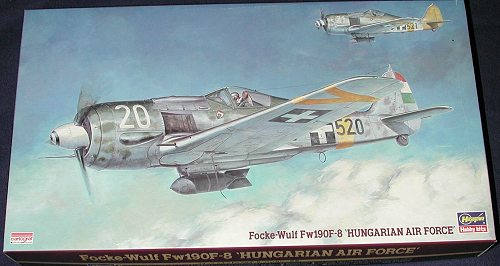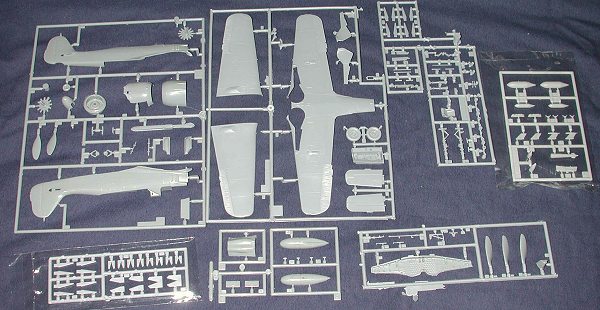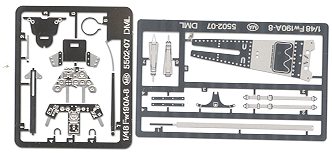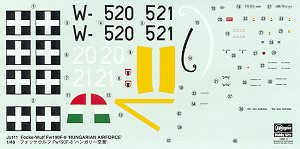
|
KIT: |
Hasegawa 1/48 Fw-190F-8 |
|
KIT # |
09211 (Jx 111) |
|
PRICE: |
$ |
|
DECALS: |
Two very similar aircraft |
|
REVIEWER: |
|
|
NOTES: |
Reboxed Dragon Fw-190A-8 kit with extras. |

|
HISTORY |
By the time that Focke-Wulf FW-190 production reached the A-8 version, the very similar ground attack or jabo version was being built side by side on the assembly line. The reason was that these aircraft were nearly identical with respect to basic airframe and engine. The only real differences were in armament. Initially, the requirement for a jabo 190 was for additional armor protection and for the inclusion of four wing racks (two on each side) capable of handling a 50 kg bomb. However, the increased weight of the armor plating and the wing racks/bombs to the standard aircraft was too much so initial aircraft were delivered without the wing racks. Removal of the outer wing guns reduced the weight so that the racks could be installed. Contrary to popular belief, the landing gear was not strengthened in any way, only the shock absorber pressure was increased to handle the additional weight.
The Fw-190F-8 variant production was started in March of 1944 along with the A-8 fighter. Initial production aircraft had sand filters and lots of armor as standard equipment. However, because all this weight adversely affected the handling and speed of the plane, all armor protection except the engine oil cooler ring and armored windscreen were removed. Much of this loss of speed was gained back by more powerful BMW 801 engines in later versions. In late 1944 new ETC 71 bomb racks, which were slimmer, lighter and cheaper to build replaced the older under wing racks. The centerline rack was also replace in many planes with a slimmer, lighter and cheaper ETC 504 rack that replace the ETC 501. In January 1945 the new 'blown' canopy was introduced on the production line and retrofitted to many older versions. Along this time more wood was used in construction of the plane including tail assemblies, flaps, propellers, and interior parts. A very similar Fw-190F-9 was produced starting in November 1944. It had a more powerful engine and differed from the F-8 by a 14 blade engine fan (vice 12) and a wider 'paddle bladed' prop. In all other respects they were identical.
|
THE KIT |

Gee, I didn't know that Hasegawa did any FW-190s. Well, they don't, at least, they don't have any in-house designed kits. This one is a reboxed Dragon/DML version with Hasegawa decals. Let me back up a bit and say that MOST of it is the Dragon kit. There are two sprues in a lighter grey plastic that have the bombs and other jabo bits which are not part of the DML kit. I'll hit on that a bit later.
Since it is the Dragon kit, you can expect it to be the most accurate 190 out there and also the most difficult to build. I know that Tamiya's 190F is undoubtedly a lot easier to construct, but there have been some complaints about wheels too small and other inaccuracies surrounding Tamiya Focke Wulf kits. Having successfully built the Trimaster Fw-190A-8, I can tell you that this one should be no more difficult, yet it will take careful construction.
The parts are superbly molded with nicely engraved panel lines. Many of the
items that were in cast metal for the Trimaster kit have been reproduced
in plastic for this version. There are a number of options that the builder may
want to consider and he might also want to deviate from the instructions to do
the variant that he wishes. The instructions would have you do a single
centerline rack for what appears to be a 250kg bomb, yet included in the kit are
two smaller outer wing racks and two smaller 50 kg bombs to go along with them.
It would not be unusual for a plane to be carrying these racks as well. What
 would be unusual would be
the single X-4 missile that is included in the 'not used' portion of the sprues.
To my knowledge, none of these were used operationally. Also in the 'not used'
category is the larger 14 blade fan and wider prop blades used on the A-9/F-9
version of the 190. So you could easily use this kit to portray that variant, if
you can find decals to go along with it. A highlight of the Trimaster/Dragon
kits was the etched metal frets and those have been included with this kit.
These are used for instrument panels, seat belts, antennas and some other
smaller pieces.
would be unusual would be
the single X-4 missile that is included in the 'not used' portion of the sprues.
To my knowledge, none of these were used operationally. Also in the 'not used'
category is the larger 14 blade fan and wider prop blades used on the A-9/F-9
version of the 190. So you could easily use this kit to portray that variant, if
you can find decals to go along with it. A highlight of the Trimaster/Dragon
kits was the etched metal frets and those have been included with this kit.
These are used for instrument panels, seat belts, antennas and some other
smaller pieces.
 Instructions are the usual
excellent ones typical of Hasegawa kits. One thing I found a bit odd is that
they tell you to add the upper wing cannon bulges for the outer guns, yet three
steps later have you remove the shell ejector chutes for these same guns from
the lower wing. It seems to me that if there are no outer wing guns (and
typically on the jabos there wasn't), then one should not be installing the
upper wing gun bulges. I also find it odd that having a drop tank on this kit
version would be an option as if you are really doing a ground attack plane,
then you'd want the bomb rack installed on the centerline. Of course, should you
decide to use the wing racks, then having just the wing bombs and a drop tank
would make sense. Decals (by Cartograf) are provided for two Hungarian aircraft, both
identically painted in RLM 74/75/76 and one with a yellow tail. If you don't
like the kit decals, then an older
Aeromaster sheet on the Hungarian Air Force also has these markings
included. Aeromaster has these planes painted in RLM 82/75/76 which would
be more logical for a late war plane.
Instructions are the usual
excellent ones typical of Hasegawa kits. One thing I found a bit odd is that
they tell you to add the upper wing cannon bulges for the outer guns, yet three
steps later have you remove the shell ejector chutes for these same guns from
the lower wing. It seems to me that if there are no outer wing guns (and
typically on the jabos there wasn't), then one should not be installing the
upper wing gun bulges. I also find it odd that having a drop tank on this kit
version would be an option as if you are really doing a ground attack plane,
then you'd want the bomb rack installed on the centerline. Of course, should you
decide to use the wing racks, then having just the wing bombs and a drop tank
would make sense. Decals (by Cartograf) are provided for two Hungarian aircraft, both
identically painted in RLM 74/75/76 and one with a yellow tail. If you don't
like the kit decals, then an older
Aeromaster sheet on the Hungarian Air Force also has these markings
included. Aeromaster has these planes painted in RLM 82/75/76 which would
be more logical for a late war plane.
|
CONCLUSIONS |
Well, this is a nice kit, even if it isn't a Hasegawa original. I'd be lying if I said this would be easy to find as it probably won't. The box is dated 1996 (yup, 7 years ago), so you'll have to use the various resellers to locate it. What it does offer is the ability to do any one of four sub-variants and a rather neat X-4 Missile. At least five F-8s were tested with this missile on the centerline rack, though I've not seen any photos of these planes.
|
REFERENCE |
Closeup #8: FW-190F-8, Monogram Publications, 1986
If you would like your product reviewed fairly and quickly by a site that has well over 175,000 visitors a month, please contact me or see other details in the Note to Contributors.